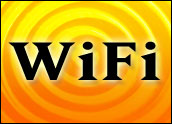
Looking for an Internet connection when out and about may soon become a lot easier.There’s been an uptick in public WiFi availability.
Recent public WiFi launches include Google’s free WiFi project in New York City,starting with parts of Chelsea. London’s tube network went hot in 2012 with 92 underground stations WiFi-enabled; Virgin Media is connecting a further 28 stations by the end of March, 2013. Also, Thailand is expanding Bangkok’s current 200,000 public WiFi hot spots to the rest of the country over the next year.
It was understandable to see investment in municipal and outdoor wireless Internetprojects during the days of slow mobile Internet in the naughties, but with modernmobile networks coming online — like LTE and other fast-ish technologies — why are weseeing this continued interest in public WiFi?
Were lessons not learned in the mid-to-late 2000s when we saw some expensive municipal WiFi failures? WiFi projects collapsed then for reasons related to lack of demand, cost and unsuitable technology. Today however, data demand has exploded due to the smartphone revolution, and WiFi technology is better.
Why WiFi’s Still In
One company that has been specializing in municipal and outdoor infrastructure is Ruckus Wireless. Ruckus has been active in WiFi — building networks for large-scale sporting events, hotels, schools, conventions — and importantly, backup to telco-offered services. Brazil’s largest telco, Oi, is using Ruckus to supply indoor and outdoor access points to support 3G expansion.
Ruckus has developed proprietary technology it calls “Smart WiFi” that it says has gotten a handle on a technological scourge: interference. Ruckus uses new adaptive antenna arrays and algorithms that choose the best signal path, sending signals only where they are needed — often around obstacles.
Still, why is WiFi still in the game when widespread mobile network LTE adoption appears to be right around the corner?
“Most geographies are seeing traffic growth of 50-100 percent year-on-year with no end in sight,” Steve Hratko, Ruckus’ director of carrier marketing, told TechNewsWorld.
“It is easy to do the math here and see that this will easily overwhelm the existing mobile infrastructure, even with LTE deployments,” he said.
“Simply put, carriers need WiFi. LTE alone won’t be able to handle the insatiable appetite for more capacity, as the proliferation of mobile devices worldwide, like smartphones and tablets, continues to grow at a rapid pace,” explained Hratko.
WiFi is the most economical and capacity-rich technology to help carriers address the tremendous acceleration in mobile data traffic, in his view, particularly within high-density areas.
Also, WiFi offers some consumer benefits, compared to LTE, Esme Vos, founder of MuniWireless, told TechNewsWorld.
“Municipal WiFi remains the more desirable option, because if done properly, it is muchfaster and allows the user to evade data caps and other nasty telco tricks,” she said.
From a consumer standpoint, it also allows travelers to avoid roaming charges, added Vos.
Unburdening Cellular
Another advantage of outdoor WiFi today is that it can serve as an offload mechanism to alleviatecellular bandwidth concerns, noted consultant Rory Conaway, who writes for MuniWireless.
This is particularly applicable as new WiFi frequencies and technologies become available that deal with the historically troublesome area of interference and radio-propagation-related noise.
“Outdoor WiFi is designed to offload users from using cellular bandwidth,” said Conaway.
“In many cases, carriers are limited to about 10 Mhz, which doesn’t lend itself to the high-bandwidth needs of users,” he explained. “Although LTE is more bandwidth-efficient than WiFi, eachtower covers a much larger area, meaning more users. WiFi coverage zones are much smaller and have a 20 MHz channel.
More channel capacity means more radio traffic.
“The problem with outdoor WiFi is that there is so much noise in the unlicensed 2.4 Ghz bands that it’s difficult to get more than a couple hundred feet to a smartphone — and even worse attempting to penetrate trees and buildings,” noted Conaway.
Dual-band Access Points, which add cleaner 5 GHz spectrum to the mix, help with noise — although the 5 GHz band has a shorter range through obstructions. A new standard called “802.11ac,” the next-generation WiFi technology, uses 5 GHz.
The Federal Communications Commission has recently announced that it will release another 195 MHz in the 5 GHz band for WiFi, although the caveat is that 5 GHz’s range issues have meant that the band has been used so far primarily for line-of-sight backhaul and short-range home or office technology.
As a smartphone-driven data capacity crunch looms — and we are seeing mobile cellular network capacity issues at major events, and in dense conurbations — it may not be a case of if, but when we see more widespread WiFi launches. Deja vu all over again.






















































Great article – just a couple of comments: It is true that 2.4 GHz is starting to get congested, but 5 GHz is already here. The iPhone 5 supports it already and so does a lot of other devices, so you don’t have to wait for 802.11ac. iPhone 5 even supports two 5 GHz channels giving giving two or three times the regular Wi-Fi speed on the current Wi-Fi version 802.11n. Another critical point: Wi-Fi service providers can today offer SEAMLESS roaming of cellular subscribers with for example iPhones or Android devices. The phone will automatically pick up the Wi-Fi signal and be connected – without any logon needed. Very clever and super convenient. This is the no. 1 method of offloading cellular networks today and offering connectivity that is as good as 3G and close to LTE. If you need to know more about this contact me at [email protected]